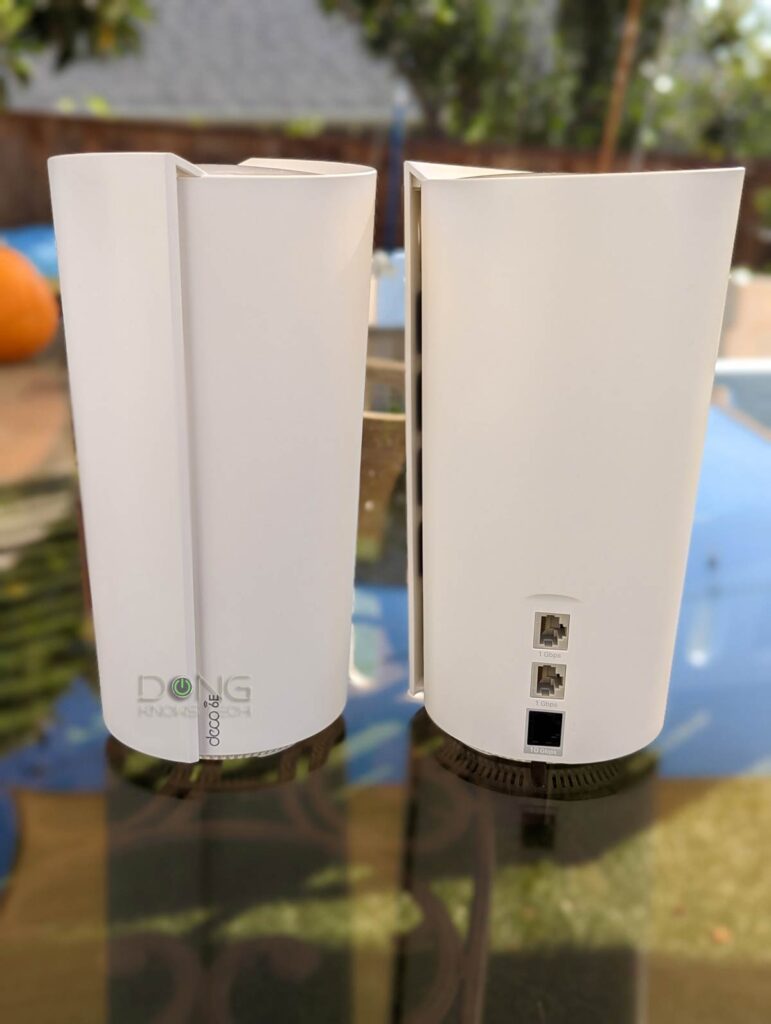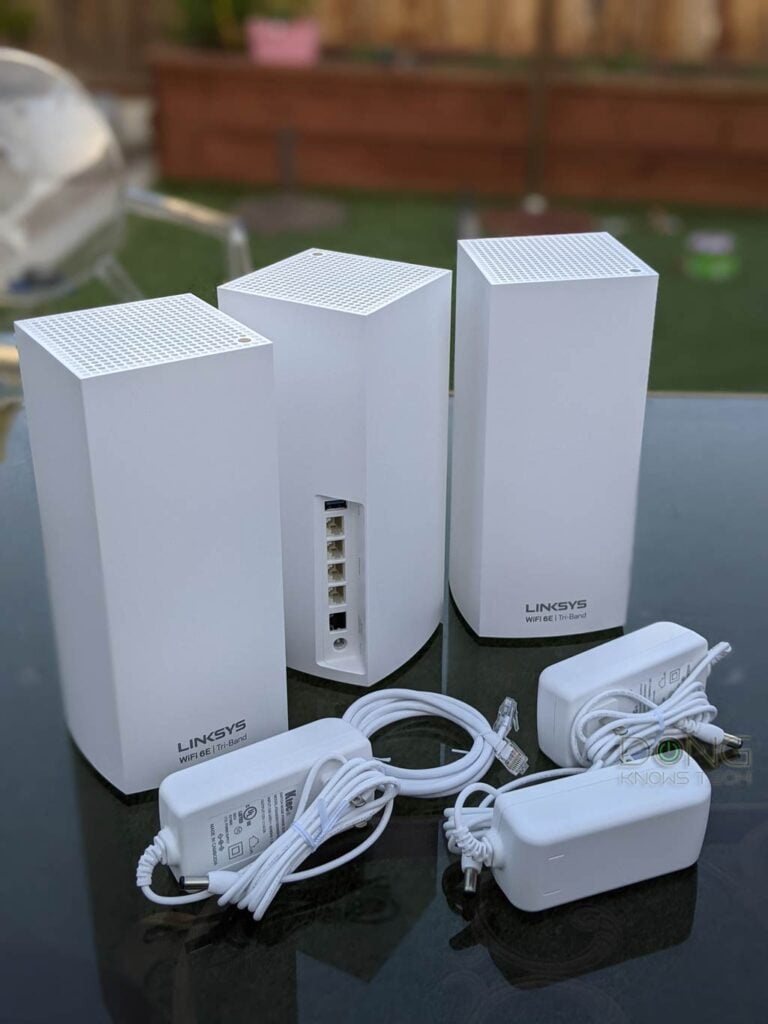This list includes the best among all Wi-Fi 6E mesh systems I’ve reviewed. Most importantly, they are the results of months, even years, in real-world usage.
Wi-Fi 7 became official in the first days of 2024, but the new standard will still need a few years to mature. Until then, Wi-Fi 6E—an extension of Wi-Fi 6, which is, in my book, currently the best Wi-Fi standard to buy—is more affordable and delivers the same experience for most homes.
A Wi-Fi 6E mesh gives you a genuine taste of the new 6GHz band, particularly when used in a wired home, and is forward-compatible with any Wi-Fi 7 client and beyond.
Dong’s note: I originally published this frequently-revised piece on October 30, 2022, and last updated it on December 7, 2024.
Wi-Fi 6E mesh systems: A couple of important notes
Wi-Fi 6E has the same features and speed grades as Wi-Fi 6 but with an additional 6GHz band.
This band is cleaner and, therefore, can achieve the top speed more efficiently with better reliability. On the downside, the 6GHz has a noticeably shorter range than the 5GHz and 2.4GHz. And that makes things tricky for Wi-Fi 6E mesh systems—no band can work reliably as the backhaul without signal loss.
The point is this: If you’re looking into Wi-Fi 6E mesh with hopes of fast wireless performance (and rightfully so), it’s best to use it via wired backhauling—get your home wired! If wiring is not an option, you should stick with a tri-band Wi-Fi 6 system that supports UNII-4.
Extra: Fronthaul vs. backhaul
When you use multiple Wi-Fi broadcasters—in a mesh network or a combo of a router and an extender—there are two types of connections: fronthaul and backhaul.
Fronthaul is the Wi-Fi signals broadcast outward for clients or the local area network (LAN) ports for wired devices. It’s what we generally expect from a Wi-Fi broadcaster.
Backhaul (a.k.a backbone,) on the other hand, is the link between one satellite Wi-Fi broadcaster and another, which can be the network’s primary router, a switch, or another satellite unit.
This link works behind the scenes to keep the hardware units together as a system. It also determines the ceiling bandwidth (and speed) of all devices connected to the particular broadcaster. It’s the backbone of the system.
When a Wi-Fi band handles backhaul and fronthaul simultaneously, only half its bandwidth is available to either end. From the perspective of a connected client, that phenomenon is called signal loss.
When a Wi-Fi band functions solely for backhauling, it’s called the dedicated backhaul. Often, that means no other band will do this job, though that depends on the hardware.
In a mesh system, only traditional Tri-band hardware—those with an additional 5GHz band—can have a dedicated backhaul band without ostracizing clients of the same band.
Generally, it’s best to use network cables for backhauling—wired backhauling, which is an advantage of mesh hardware with network ports. In this case, a satellite broadcaster can use its entire Wi-Fi bandwidth for front-hauling.
In networking, network cables are always much better than wireless in speed and reliability.
A Wi-Fi 6E mesh system will work in a wireless configuration—even quite well if you live in an airy home. However, most of the time, your mileage will vary significantly in both real-world sustained rates and coverage.
With Wi-Fi 7 now officially available, chances are there won’t be new Wi-Fi 6E broadcasters in the future. With that, let’s check out the current, and likely the last, top five options listed in the recommended order with the best on top.
1. Asus ZenWiFi Pro ET12: True Multi-Gigabit wired mesh set

The ZenWiFi Pro ET12 is Asus’s second Wi-Fi 6E mesh system and is meant to supersede the ET8 (below) in hardware specs.
It remains a tri-band system without an additional band to work as backhaul, such as the case of the ZenWiFi Po XT12 Wi-Fi 6 counterpart.
Thanks to the top-tier Wi-Fi specs and the two 2.5Gbps Multi-Gig ports, the ZenWiFi Pro ET12 is also the best mesh Wi-Fi system with entry-level multi-Gigabit wired backhauling and can consistently deliver Gig+ Wi-Fi performance to Wi-Fi 6 and newer clients.
Pros
Wi-Fi 6E-ready, extensive Wi-Fi coverage with top performance in specific setups with possible fast Wi-Fi performance in certain setups
Dual Multi-Gig ports with multi-Gigabit wired backhauling, flexible port configurations
Excellent performance and coverage as a standalone router
Tons of useful features and settings, flexible Wi-Fi customization
Helpful mobile app; no login account required
Cons
Bulky, no USB, only four network ports
Fluctuating performance as a fully wireless mesh due to the lack of a dedicated backhaul band
Expensive, not wall-mount-ready
2. TP-Link Deco XE200: A solid mesh that’s somewhat a missed opportunity


The Deco XE200 is the highest-tier Wi-Fi 6E mesh system in TP-Link’s popular Deco family. Unfortunately, having just one Multi-Gig port, it fails to be the ultimate mesh—there’s no chance for a Multi-Gig wired backhauling setup unless you use it in the AP mode with a multi-Gigabit non-Wifi router.
Still, for those with Gigabit or slower broadband, the XE200 is an excellent buy. Alternatively, consider the lesser yet similar TP-Link Deco XE75 or the Pro version if you have Gigabit-class broadband.
Pros
10Gbps port, 6GHz support, top-tier Wi-Fi, reliable Wi-Fi performance with extensive coverage
Easy to use; comparatively affordable
Cons
Single Multi-Gig port, spartan Wi-Fi, and network customization
Fluctuating Wi-Fi speeds, Mobile app, and login account required; HomeShield Pro costs money
No USB port, impractical design
3. Asus ZenWiFi ET8: Excellent for a wired home with Gigabit broadband


The ZenWiFi ET8 is Asus’s Wi-Fi 6E alternative to the ZenWiFi XT8, which is a purpose-built Wi-Fi 6 mesh system for a fully wireless setup. In that sense, the ET8 is not an upgrade to the older cousin—it’s not great for a wireless configuration. Instead, like all Wi-Fi 6E systems, it’s an alternative for an airy home or one already wired with network cables.
Like the Deco XE200 above, each ET8 router has only one Multi-Gig port—the entry-level 2.5Gbps—so there’s no chance of multi-Gigabit wired backhauling unless you use it in the AP mode for a non-Wifi router.
Alternatively, you can also consider the ZenWiFi ET9, which has slightly better hardware specs, more hardware options, and similar pricing.
Pros
Reliable and extensive coverage with possible fast Wi-Fi performance with wired backhauling
Wi-Fi 6E ready, Multi-Gig WAN, and Dual-WAN support
Excellent as a standalone router
Tons of useful features and settings, flexible Wi-Fi customization
Cons
Comparatively slow performance in most use cases
Short 6GHz range; unreliable with wireless backhauling
No Link Aggregation or Multi-Gig LAN port
Only one Multi-Gig port on each hardware unit
4. Netgear Orbi RBKE960 Series: A sticker shock with excellent performance


Available as a 3-pack—RBKE963 (white) or RBKE963B (black)—Netgear’s first quad-band Orbi Wi-Fi 6E system is insanely expensive, costing $1500 at launch—and you have the option to pay even more over the Armor add-on subscriptions.
Furthermore, it includes fewer features and settings than previous Orbi sets. In return, you’ll get substantial and uniquely quad-band hardware and support for Multi-Gig wired backhauling.
Pros
Powerful hardware with quad-band Wi-Fi and Multi-Gig wired backhaul support
Excellent Wi-Fi coverage, fast performance
More Wi-Fi networks than previous Orbis, including two additional virtual SSIDs
Cons
No web-based Remote Management, few free features; mobile app (with a login account and even subscriptions) is required to be useful
Rigid Multi-Gig ports’ roles, few Multi-Gig ports
The 2nd 5GHz band is unavailable to clients even with wired backhaul; no 160MHz channel width on 5GHz
Limited Wi-Fi customization, bulky design
5. Linksys AXE8400 Atlas Max 6E: A reliable Wi-Fi 6E mesh system


Besides the MR7500 router, the AXE8400 Atlas Max 6E is Linksys’s 2nd 6E solution. The mesh consists of three identical tri-band 6E broadcasters, model MX8500. Each can work as a standalone router, but you can combine them into a system to deliver coverage of all three bands (2.4GHz, 5GHz, and 6GHz) in a large property.
Pros
Reliable performance, extensive coverage
Excellent NAS performance when hosting external storage device(s)
Separate SSID for each band
Cons
Comparatively slow mesh Wi-Fi speeds in homes with walls
Limited Wi-Fi settings and features, mobile app coercion
No Multi-Gig LAN port at the primary router, Dual-WAN, or Link Aggregation
No setting backup and restore
Best Wi-Fi 6E mesh systems: The takeaway
Wi-Fi 6E is the stop-gap extension that bridges Wi-Fi 6 to Wi-Fi 7. With the 6GHz’s innate short range, it’s a standard designed for homes without (a lot of) walls or already equipped with network cables. Otherwise, a Wi-Fi 6E mesh system will not deliver faster Gigabit performance.
Again, it’s best to use Wi-Fi 6E mesh with wired backhauling. If you have no network cables, Wi-Fi 6 hardware with an additional 5GHz band that can work as a dedicated backhaul, especially those supporting the UNII-4 portion of the 5GHz spectrum, is recommended.







